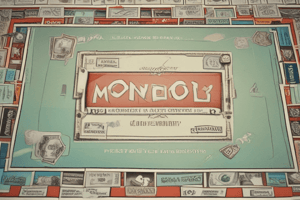Podcast
Questions and Answers
What is the optimal price for the firm in this scenario?
What is the optimal price for the firm in this scenario?
- 5
- 6
- 4 (correct)
- 3
What is the maximum profit the firm can earn?
What is the maximum profit the firm can earn?
- 0.5
- 2
- 1 (correct)
- 1.5
At what price does the firm begin to experience diminishing marginal returns?
At what price does the firm begin to experience diminishing marginal returns?
- 5 (correct)
- 4
- 3
- 6
What is the firm's total revenue when the price is 3?
What is the firm's total revenue when the price is 3?
What is the firm's total cost when the price is 2?
What is the firm's total cost when the price is 2?
What is the firm's marginal cost when the price is 5?
What is the firm's marginal cost when the price is 5?
At what price does the firm's profit begin to decrease?
At what price does the firm's profit begin to decrease?
What is the firm's marginal revenue when the price is 2?
What is the firm's marginal revenue when the price is 2?
What is the elasticity of demand for the given demand equation: q = 2 − 15p?
What is the elasticity of demand for the given demand equation: q = 2 − 15p?
What is the term used to describe the difference in total surplus between a monopoly and a competitive market?
What is the term used to describe the difference in total surplus between a monopoly and a competitive market?
What is the primary goal of an antitrust policy?
What is the primary goal of an antitrust policy?
In the context of the Facebook vs FTC case, what did the FTC accuse Facebook of doing?
In the context of the Facebook vs FTC case, what did the FTC accuse Facebook of doing?
What was the primary objective of the FTC's lawsuit against Facebook?
What was the primary objective of the FTC's lawsuit against Facebook?
Which of the following is a potential solution to correct the market failure caused by monopolies?
Which of the following is a potential solution to correct the market failure caused by monopolies?
Why does a monopoly typically set a price ‘too high’ and a quantity ‘too low’ compared to a competitive market?
Why does a monopoly typically set a price ‘too high’ and a quantity ‘too low’ compared to a competitive market?
What is the term used to describe the situation where a company has complete control over a particular market?
What is the term used to describe the situation where a company has complete control over a particular market?
Which of the following is NOT a benefit of competition in a market?
Which of the following is NOT a benefit of competition in a market?
What is the formula for price, derived from the elasticity rule, in terms of marginal cost (MC) and price elasticity of demand (e)?
What is the formula for price, derived from the elasticity rule, in terms of marginal cost (MC) and price elasticity of demand (e)?
What key relationship does the elasticity rule derive from?
What key relationship does the elasticity rule derive from?
The elasticity rule states that the ratio of (p - MC) to p is equal to what?
The elasticity rule states that the ratio of (p - MC) to p is equal to what?
What is the correct formula for calculating Price Elasticity of Demand (e)?
What is the correct formula for calculating Price Elasticity of Demand (e)?
Which of the following is NOT a direct implication of the elasticity rule?
Which of the following is NOT a direct implication of the elasticity rule?
Given an inverse demand curve of p = P(q), how is total revenue (TR) calculated?
Given an inverse demand curve of p = P(q), how is total revenue (TR) calculated?
What is the formula for calculating the marginal revenue (MR) from the inverse demand curve, p = P(q), using the product rule?
What is the formula for calculating the marginal revenue (MR) from the inverse demand curve, p = P(q), using the product rule?
To find the optimal price (p*) and quantity (q*) using the MR = MC approach, what must you first do?
To find the optimal price (p*) and quantity (q*) using the MR = MC approach, what must you first do?
What was the primary reason the court dismissed the FTC's challenge against Facebook's monopoly status?
What was the primary reason the court dismissed the FTC's challenge against Facebook's monopoly status?
Which of these companies was not a result of breaking up Standard Oil?
Which of these companies was not a result of breaking up Standard Oil?
Why was AT&T broken up into smaller firms in 1984?
Why was AT&T broken up into smaller firms in 1984?
Which of the following is NOT an example of a natural monopoly?
Which of the following is NOT an example of a natural monopoly?
What is the primary goal of marginal cost pricing regulation?
What is the primary goal of marginal cost pricing regulation?
Why is forcing a monopolist to set p = MC a potential problem?
Why is forcing a monopolist to set p = MC a potential problem?
What is one proposed solution to the problem of negative profits under marginal cost pricing?
What is one proposed solution to the problem of negative profits under marginal cost pricing?
What is the main difference between marginal cost pricing and average cost pricing?
What is the main difference between marginal cost pricing and average cost pricing?
What is the primary purpose of average cost pricing as a regulatory strategy?
What is the primary purpose of average cost pricing as a regulatory strategy?
In the context of average cost pricing, how does the price compare to the monopolist's price in a purely unregulated scenario?
In the context of average cost pricing, how does the price compare to the monopolist's price in a purely unregulated scenario?
What is the significance of the term 'rate of return regulation' in the context of average cost pricing?
What is the significance of the term 'rate of return regulation' in the context of average cost pricing?
What is the primary benefit of average cost pricing, as opposed to marginal cost pricing, for a regulated monopolist?
What is the primary benefit of average cost pricing, as opposed to marginal cost pricing, for a regulated monopolist?
Which of the following is NOT a potential solution to market failure in a monopoly market?
Which of the following is NOT a potential solution to market failure in a monopoly market?
Which of the following correctly describes the relationship between the monopolist’s price (pm) and the average cost pricing price (pac) in the provided graph?
Which of the following correctly describes the relationship between the monopolist’s price (pm) and the average cost pricing price (pac) in the provided graph?
How does average cost pricing relate to a competitive market outcome in terms of quantity produced and price?
How does average cost pricing relate to a competitive market outcome in terms of quantity produced and price?
What is the key difference between marginal cost pricing and average cost pricing in terms of the price set for the monopolist?
What is the key difference between marginal cost pricing and average cost pricing in terms of the price set for the monopolist?
Flashcards
Elasticity Rule
Elasticity Rule
Relationship between price, margin, and elasticity: (p - MC) / p = -1/e.
Inverse Elasticity
Inverse Elasticity
The reciprocal of elasticity; represents how demand changes with price.
Marginal Cost (MC)
Marginal Cost (MC)
The cost of producing one additional unit of a good or service.
Marginal Revenue (MR)
Marginal Revenue (MR)
Signup and view all the flashcards
Total Revenue (TR)
Total Revenue (TR)
Signup and view all the flashcards
Demand Curve Equation
Demand Curve Equation
Signup and view all the flashcards
Applying Product Rule
Applying Product Rule
Signup and view all the flashcards
Setting MR = MC
Setting MR = MC
Signup and view all the flashcards
Elasticity of Demand
Elasticity of Demand
Signup and view all the flashcards
Elasticity Calculation
Elasticity Calculation
Signup and view all the flashcards
Negative Elasticity
Negative Elasticity
Signup and view all the flashcards
Optimal Pricing
Optimal Pricing
Signup and view all the flashcards
Welfare Costs of Monopoly
Welfare Costs of Monopoly
Signup and view all the flashcards
Producer Surplus
Producer Surplus
Signup and view all the flashcards
Competitive Price/Quantity
Competitive Price/Quantity
Signup and view all the flashcards
Elasticity Rule Use
Elasticity Rule Use
Signup and view all the flashcards
Consumer Surplus
Consumer Surplus
Signup and view all the flashcards
Monopoly Pricing
Monopoly Pricing
Signup and view all the flashcards
Dead-weight Loss
Dead-weight Loss
Signup and view all the flashcards
Market Failure
Market Failure
Signup and view all the flashcards
Antitrust Policy
Antitrust Policy
Signup and view all the flashcards
Facebook FTC Case
Facebook FTC Case
Signup and view all the flashcards
Divestiture
Divestiture
Signup and view all the flashcards
Price Optimization
Price Optimization
Signup and view all the flashcards
FTC Monopoly Case
FTC Monopoly Case
Signup and view all the flashcards
Standard Oil
Standard Oil
Signup and view all the flashcards
AT&T Breakup
AT&T Breakup
Signup and view all the flashcards
Natural Monopolies
Natural Monopolies
Signup and view all the flashcards
Marginal Cost Pricing
Marginal Cost Pricing
Signup and view all the flashcards
Negative Profit in Monopoly
Negative Profit in Monopoly
Signup and view all the flashcards
Government Subsidy
Government Subsidy
Signup and view all the flashcards
Average Cost Pricing
Average Cost Pricing
Signup and view all the flashcards
Optimal Price
Optimal Price
Signup and view all the flashcards
Monopolist
Monopolist
Signup and view all the flashcards
Profit Maximization
Profit Maximization
Signup and view all the flashcards
Demand and Total Cost
Demand and Total Cost
Signup and view all the flashcards
Zero Profit Condition
Zero Profit Condition
Signup and view all the flashcards
Rate of Return Regulation
Rate of Return Regulation
Signup and view all the flashcards
Solutions to Monopoly Market Failure
Solutions to Monopoly Market Failure
Signup and view all the flashcards
Competitve Price vs Monopolist's Price
Competitve Price vs Monopolist's Price
Signup and view all the flashcards
Study Notes
ECN 453: Pricing and Monopoly
- This course covers optimal pricing strategies for monopolists
- The optimal price maximizes profit
- This is useful for policymakers to understand welfare reduction caused by monopolies
- Firm strategy seeks to maximize profits when launching new products
- Most content will be review from previous courses
Plan
- Pricing example using a table
- Pricing using MR = MC
- Pricing using elasticities
- Welfare costs of monopoly pricing and regulation
Pricing: Example Using a Table
- Tables show demand, total revenue (TR), marginal revenue (MR), total cost (TC), marginal cost (MC), and profit for different prices
- Optimal price found by raising prices as long as MR > MC
- Example provided with pricing, demand, TR, MR, TC, MC, and profit
- Optimal price maximizes profit (in whole numbers)
Pricing: MR = MC
- Optimal price occurs where marginal revenue (MR) equals marginal cost (MC)
- This is a crucial formula
- The previous example only considered whole numbers of the product
- When selling fractions, the optimal price occurs when MR = MC
Pricing: MR = MC: Monopoly Example
- A monopolist faces a demand curve q = 2 - p/5 and constant marginal cost of 5
- The optimal price is found by using the formula MR = MC (and double the slope formula)
- Finding the optimal quantity, q*, gives q* = 0.5
- Substituting q* into the demand curve provides the optimal price p* = 7.5
Pricing: MR=MC: Algorithm
- Steps for finding optimal price for a monopolist given demand and marginal cost
- Calculate marginal revenue from demand curve
- Use MR = MC to solve for optimal quantity
- Substitute optimal quantity into demand curve to get optimal price
Pricing: MR=MC: Graph
- Graphs illustrate demand (D), marginal revenue (MR), and marginal cost (MC) curves
- The optimal price (p*) and quantity (q*) are where the MR and MC curves intersect
- Optimal price is determined graphically, using the intersection point on the demand curves
Pricing: Elasticities
- A relationship exists between optimal price and demand elasticity
- This is known as the elasticity rule
- Elasticity rule is given by: (p-MC)/p = -1/ε
- ε represents inverse of elasticity
Elasticity Rule: Math (Optional)
- The elasticity rule stems from the equation MR = MC
- Applying the product rule provides the optimal equation used
- Useful for real-world empirical applications
- Economists use econometric methods (outside of the course scope) to determine demand elasticity
- The elasticity rule provides a method to calculate the optimal price when marginal cost and demand elasticity are known
Elasticity Rule
- Illustrates relationship between optimal price and demand elasticity
- Formula: (p − MC)/p = −1/ε
- ε is inversely related to elasticity
- Useful for real-world pricing applications
Using the Elasticity Rule
- Practical use for real-world pricing applications
Welfare Costs of Monopoly Pricing
- Graphs illustrate monopoly's price/quantity vs competitive price/quantity
- Show producer surplus (area labeled A), consumer surplus (area labeled B), and deadweight loss (area labeled C)
- Monopoly pricing leads to higher prices and lower quantity than under competitive conditions
- Deadweight loss is the area between perfect competition and monopoly curves
Welfare Costs of Monopoly Pricing: Summary
- Competition tends to produce prices maximizing total surplus
- A monopolist chooses the firm's optimal and profit maximizing price and quantity
- Monopoly pricing typically results in a lower quantity sold than would occur under competition.
- Causes deadweight loss
- Monopoly represents a market failure
Regulating Monopolies
- Methods to correct monopoly market failures
- Breaking up monopolies
- Regulating monopolies (anti-trust policy, used in market failures, which are due to a lack of competition)
Regulating Monopolies: Case Study of Facebook vs FTC
- Facebook acquired Instagram and WhatsApp
- The Federal Trade Commission (FTC) sued Facebook for illegal monopolization and divestiture of companies
- A court dismissed the FTC complaint due to lack of proof that Facebook was a monopoly and that the case was filed too late.
- Examples of other monopolies such as Standard Oil and AT&T that were broken up for similar reasons given by the court.
Regulating Monopolies: Other Examples of Breaking Up a Monopoly
- Standard Oil (broken up into numerous companies)
- AT&T (broken into smaller firms)
- Other examples exist, including attempted breakups of Microsoft in 2001.
- Preventing the creation of new monopolies is a key focus of antitrust policy
Regulating Monopolies: Marginal and Average Cost Pricing
- Some monopolies are "natural monopolies" (i.e., power plants, bridges)
- Regulation is needed to regulate them
- Two methods, marginal and average cost pricing
Regulating Monopolies: Marginal Cost Pricing
- Setting price equal to marginal cost (p = MC)
- This leads to perfect competition pricing
- This could potentially lead to a negative profit for the firm
- A government subsidy is needed if necessary to keep the company from shutting down
Regulating Monopolies: Average Cost Pricing
- Setting price equal to average cost (p = AC)
- Necessary to cover fixed and variable costs
- This ensures the company is not making a negative profit
- This is common in regulating privately owned power plants, and is called "rate-of-return regulation".
Summary of Key Points
- Recognize the optimal pricing occurs where MR = MC, which maximizes profit
- Understand how to solve for the monopolist's optimal price and quantity graphically and mathematically
- Learn the elasticity rule, its application to monopoly market failure, and the key elements involved in this.
- Be familiar with the three methods of addressing monopoly market failure (divestment, marginal cost pricing, and average cost pricing).
References
- Monopoly graph source
Studying That Suits You
Use AI to generate personalized quizzes and flashcards to suit your learning preferences.





